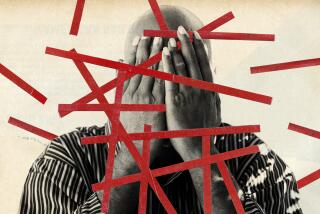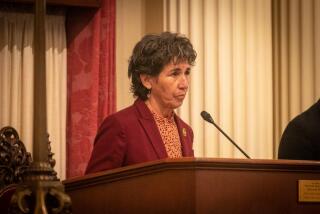Debilitating Locked-In Syndrome : It’s Like Being Buried Alive
SAN FRANCISCO — Imagine you’re in a hospital bed and nothing functions below your nose. Your mind is alert and you can see, hear and smell, but you can move nothing but your eyes.
Such a condition exists. It is called locked-in syndrome and, though very rare, it can affect stroke victims and others who suffer brain trauma.
Dave Liberman, a clinical psychologist who works with such patients, compares the condition to being buried alive.
Four years ago, Leonard Cole was a healthy, active 40-year-old fire captain. He enjoyed hunting; he did odd jobs around the house. But since a stroke, Cole cannot speak or move. He communicates with his wife, Shirley, by moving his eyes.
‘It’s Been Hard’
“It’s been hard,” Shirley Cole said in a telephone interview from their home in Fair Oaks about 100 miles east of here. “But Len has maintained a real positive attitude. We both just felt that you can’t change what is, so you must accept it and do the best you can with it.”
Only 139 cases of locked-in syndrome have been reported in medical literature since 1959, according to an article in the journal Stroke earlier this year.
Stroke is the most common cause, but cases have been produced by injury, encephalitis and tumors, said Dr. Roger Simon, head of neurology at San Francisco General Hospital who has seen only eight cases in 15 years.
According to Simon, trauma or stroke can sever connections at the reticular activating system of the brain stem, “this narrow place where your brain is connected to your spinal cord.”
Damage to the nerve centers that form the system can block messages from the brain from traveling down the spinal cord to the muscles.
Most trauma to the reticular activating system causes coma, although injury to certain parts of it turn off the systems that regulate breathing and heart rate, and the patient dies. But injury in some other spots results in locked-in syndrome.
A centimeter can make the difference between coma, death or the syndrome, Simon said.
“It’s something like a string of Christmas lights,” he said. “If you cut the wire in a particular place, some of the lights would still work, the ones near the (electrical) socket. But the others wouldn’t. In this case, the eyes and ears, those light bulbs still light up, but the others don’t.”
Some patients regain full or partial use of their bodies.
“The best outlook is very significant recovery to the point of being able to take care of yourself and go about your business and drive a car,” Simon said.
In a study of 37 locked-in patients cited in the Stroke article, six recovered with no neurological damage and 17 recovered to the extent that they were independent in daily life, but still had some neurological damage. The rest showed less recovery or none at all.
Learn to Communicate
But even in cases where no movement is regained, patients can learn to communicate with their eyes.
Shirley Cole said she and her husband can carry on relatively speedy conversations using a system in which the alphabet and numerals are arranged in a matrix. Pointing at the matrix, she moves along rows as directed by her husband’s eye movements until his look tells her which letter or number he wants.
The couple has developed a shorthand: “MP” means empty and “TU” means thank you.
“He can spell out fairly quickly anything you want to know or he wants to tell you,” Shirley Cole said.
Several computer systems allow locked-in patients to write by moving a sensor switch with their eyebrows as the computer scans a similar alphabet arrangement.
Such a system, Simon said, may help James Thomas Brennan, a 59-year-old San Francisco man who became locked-in after suffering a stroke aboard an airliner en route to Tokyo on May 29.
Coma Diagnosed
Japanese doctors apparently believed Brennan was in a coma, and only after he was flown home did Simon diagnose the condition.
“I don’t fault the people in Japan,” Simon said. “If the patient was seen by a general ‘doc’ in a small town, I think they generally would miss it. . . . The people who have intimate contact with the patient, like family and so on, often bring it to the august physician’s attention.”
Computer systems have been used in therapy for locked-in patients by Liberman, a member of the Northwestern University Medical School faculty whose practice is in Northfield, Ill.
“As time goes by, you can put things in (the computer’s) memory so the individual can page through and come up with sentences or phrases that have been used before,” he said.
“At that point, you can get into a kind of therapy. . . . You can ask them questions, or they can talk to you about the kinds of concerns they have.”
The therapy, Liberman said, is “a tricky thing because you have to balance not raising false hopes with not allowing the persons to get to the state where they just give up.”
“Not only can’t they do anything about it physically, but they can’t even talk about it,” he said. “Unless someone can help them deal with these massive stress reactions, it’ll eat them up inside.”
More to Read
Sign up for Essential California
The most important California stories and recommendations in your inbox every morning.
You may occasionally receive promotional content from the Los Angeles Times.










